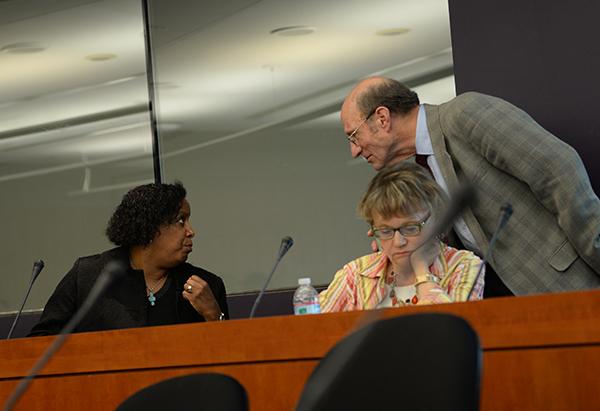
Faculty leaders voted unanimously Friday to push administrators to adopt a budget system that can forecast how unanticipated expenses could dent the University’s fragile finances.
Faculty Senate members are concerned that after top officials spent two years overhauling the University’s budget model, GW still won’t be able to forecast how expenses could compound. They said they worry GW will fall behind some peer schools that can predict expenses five to 10 years down the line.
The lobbying comes as credit agencies have warned the University about its shrinking bottom line. With that smaller financial cushion, Faculty Senate members said the budget plan needs to anticipate future projects to prevent unforeseen costs from catching officials off guard.
Next year, the University will start rolling out the system they’ve been building since 2012, without the changes presented at the Faculty Senate meeting Friday.
The new model, set to launch in 2015, will promise schools a larger portion of government subsidies based on the amount of research they conduct instead of putting money back into the central administration’s budget.
But economics professor Anthony Yezer, who wrote the Faculty Senate bill, said the new model doesn’t go far enough. He said while systems that use incentives are often successful in growing revenue, officials also need to see the consequences of long-term expenses like adding more tenured faculty or doling out more financial aid.
“We make decisions today that affect costs for years in the future,” said Yezer, who created the budget system that the U.S. Postal Service now uses. “If you’re not modeling costs and you’re making decisions that have long-run cost implications, you are one hand clapping – you have a problem.”
Yezer added that since GW relies on tuition for about 62 percent of total revenue each year, but students’ deposits aren’t due until September, officials have to create the operating budget without a full picture.
Colleges have increasingly revamped their budgeting systems and added the ability to forecast future costs. Cornell University overhauled its budget model this year to better plan for long-term expenses and generate revenue with new research.
Patrick Cain, an assistant director at the higher education consulting firm Academic Impressions, said many schools turn to these systems to make more detailed plans.
“Short term, incremental budgets don’t allow for specific, strategic direction in regard to allocation and funding,” Cain said.
Provost Steven Lerman said a long-term model would help officials forecast how changes like federal spending cuts would impact GW’s bottom line. But he said it would take years to create the system.
“This would be a much more detailed model, which would allow us to test a much wider range of scenarios,” Lerman said at the meeting. “We don’t have the tool set Yezer is calling for in his recommendation.”
Still, Lerman said the University could explore the option in the future.
“It’s one of those things that can evolve over time,” he said. “You can begin it by having a more simple set of assumptions and fill it out later and develop detail.”
Charles Garris, chair of the Faculty Senate’s executive committee, said the more modern system would ease faculty members’ concerns about a lack of transparency in the University’s budgeting process. GW’s financial management came under fire earlier this year after officials failed to catch the business school’s $13 million in overspending.
“You could see the effects of all these different decisions,” Garris said. “When you decide to hire more faculty, how does that impact things five years down the road or how does enrollment change?”
The model would also help the University manage the ups and downs of its cash flow, which change each year depending on enrollment. For the past two years, graduate student enrollment has continued to slide, stripping millions of dollars from the operating budget.
“We make decisions on the size and nature of classrooms today, and we’re stuck with them for years in the future,” Yezer said.
One of the largest financial decisions GW will make this year is how it will take on managing a long-struggling art college. The University announced in February that it would acquire the Corcoran College of Art + Design, a move that will likely require tens of millions of dollars in renovations. Administrators are still hammering out details such as Corcoran students’ cost of tuition and which faculty contracts will be renewed.
Larry Goldstein, president of the higher education financial consulting company Campus Strategies, said the most effective budget models can adapt quickly to new plans.
“It should be able to take that into consideration and deploy resources,” Goldstein said.







